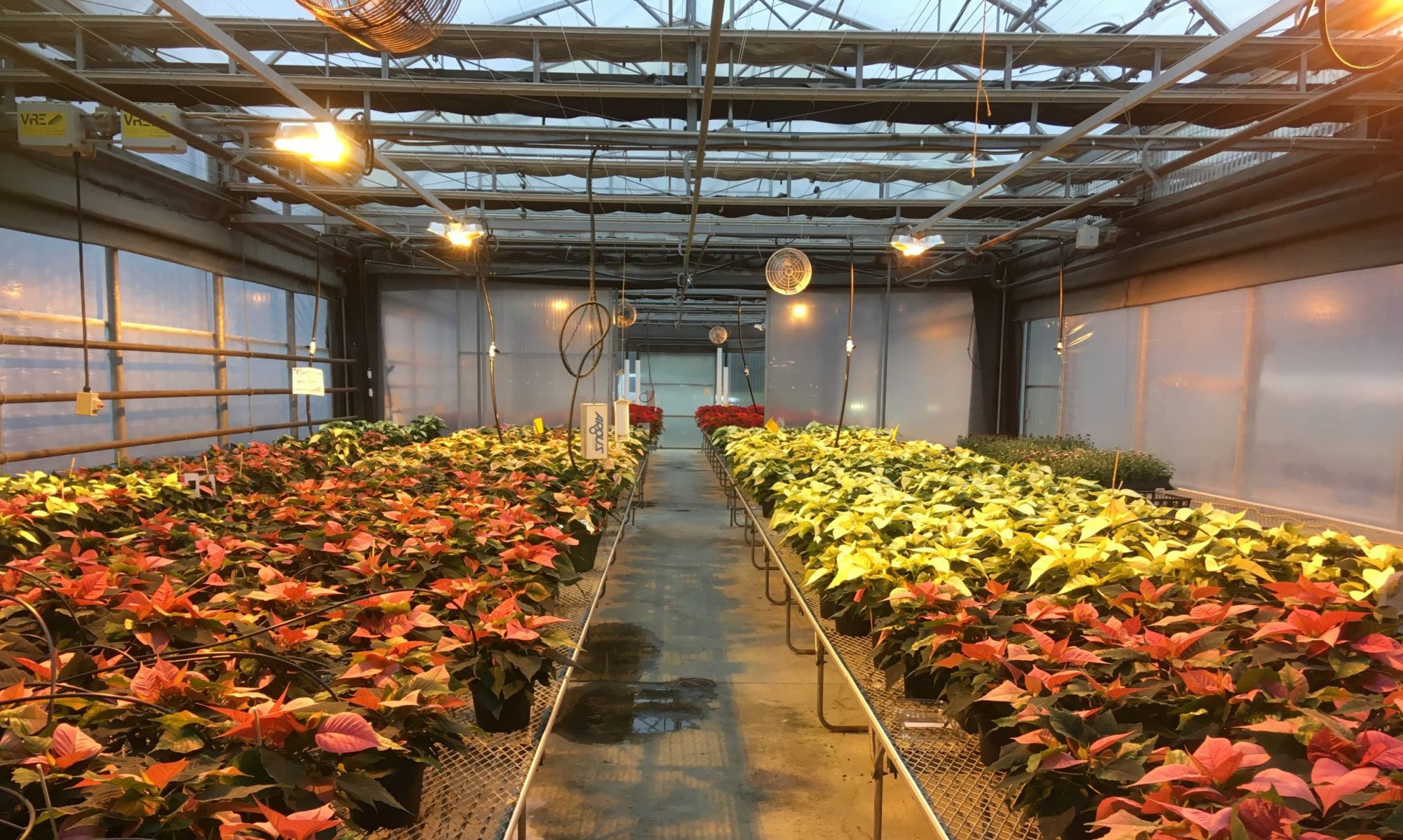Environmental Conditions:
Week 21 had consistent sun, cloud and rain for outdoor conditions with highs of 16C and lows of 5C over night. On Sunday, October 10 there was an Argus Controls emergency in the Paine Centre greenhouses and it was discovered that the vents were stuck in the open position. They have been monitored for functionality throughout the week but, likely we will need to get a new motor for the vent. This week was week 2 of 7.5/8 of our blackout photoperiod where we are initiating generate (flowering) growth. We have started our sales strategy and customers can now purchase poinsettias online through our website!
Day: Heating Setpoint 20C | Cooling Setpoint 22C
Night: Heating Setpoint 18C | Cooling Setpoint 20C
Continuing our temperature regime from last week, we used Argus Controls to create two distinctive temperature zones. Our day period, which corresponds directly to our literal (or solar) day period (light is getting to the crop) is running higher than our night period; this means we are running a positive diff. A negative diff is if we were running a warmer night period than day period.
We needed to create a greater and distinct difference between the day and night temperatures to trigger generative growth. Its important to remember that our temperature zones are dynamic, and we can change the, based on our height measurements and our visual inspections of our crop.
Supplemental Lighting:
We are running a 9-hour day and a 15-hour night to trigger the plants into generative growth. This is essentially what is going to turn our poinsettias red, white, or pink.
Hours of Black Out: 15 hours – 5pm to 8am.
Nutrient:
EC target is 1.5 – 2.0 pH target is 5.7 – 6.3
EC: The EC’s ranged from 0.4 – 1.6 again this week.
pH: We are starting to see an upward trend in the pH which is a good sign since last week the pH was concerningly low. We also switched from the Mg fertilizer to the CaN03 fertilizer to continue developing the roots and help bract development. This week we will focus on looking for nutrient deficiencies in our crop. Refer to VIULearn for resources.
Watering/Fertilizer:
The students assessed soil moisture on Tuesday in our face to face classes and determined that all the plants required water. We have multiple watering systems including drip, flood tables and hand watering. Students applied different methods where applicable to water the crop.
In addition to the EC measurements we used the plant heights to guide us towards our decision on what (if anything) we should water with. Our plants are sitting around 22cm and this information helps us decide what, if anything, to fertilizer with.
Now that we have started the black out it is increasingly important to be accurate in our poinsettia height measurements. Once we have triggered generative growth the plants will start to focus their growth on flowering and less towards vegetative growth meaning we have less flexibility when adjusting temperatures to direct crop height.
Observations:
- All the poinsettias are spaced and are currently being hooked up to our drip irrigation system. Its critical that we get all the poinsettias connected to the drop lines so that we have increase our labour efficiency and create uniform applications of watering/fertilizing to our crop. The 4” poinsettias in the flood table are looking crowded already as they grow into the surrounding space. We will have to work towards completing the irrigation set up this week for maximum effectiveness of time.
- The students have been taking weekly height measurements and we can see that our crop is (generally) increasing in height each week. Its critical we use correct height measuring techniques to use the most accurate information to base our decisions from. Our crop average is 27cm with Futura Brilliant Red taking the lead over Titan Pink from last week.
- We created two distinct temperature zones (see above) which will help in triggering our plants into generative growth. We will assessed the plant heights in our face to face class this week and determined that we are on trend to finishing our plants at our desired height of 40cm-42cm. We decided to keep the temperature regime the same for this week.
- Team Citrus was in the greenhouses this week and participated in lab #1 of the yellow sticky card assignment. As a class the team determined that they reached the threshold for insects in the greenhouse and that we should apply beneficial insects due to the high pest pressures. Due to the long weekend, the biologicals did not arrive until Thursday this week. I put out the biological insects on Friday to work hard at managing our pest populations over the weekend. I anticipate that pest populations will decrease over the coming weeks as we release more biological insects in the greenhouse.
- This week we did not use the side walls for passive venting very much due to lower outdoor temperatures and rain at the end of the week. We say low solar radiation this week and relied on our HPS (high pressure sodium) lights in the greenhouses now to create the day period to give our crop enough light hours to photosynthesize. I checked that the lights were off by visiting the site on Monday evening after 5pm when I knew the lights should be off.
- Moving forward it will be critical to manage greenhouse environment and pest pressure to ensure crop health throughout the next 7.5-8 weeks until sales. Speaking of sales, it is time to turn our focus to selling our crop! Please look at the week 41 section of VIULearn for updated sale information. Our online order form is ready to take orders through our website at https://tradesappliedtech.viu.ca/horticulture/form/poinsettias
*Note that our home crop is yours to keep and we won’t be selling it through the Paine Centre.




